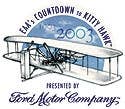
Having hired a man to run their bicycle shop, the Wrights were able to leave earlier for Kitty Hawk in 1901. They arrived at their former campsite on July 11th, full of confidence based on their previous year's testing-and with a glider of the same design, but much larger, with a wingspan of 22 feet and a weight of 98 pounds, nearly twice that of its predecessor. Their mood was tested, however, when they were greeted by a foul nor'easter with 93 mph winds and were forced to pitch their tent in the pouring rain. Four days later, they began building a hangar big enough to house their new glider, a hangar Orville thought was "a grand institution, with awnings at both ends…"
Two others, George Spratt and Edward Huffaker, arrived shortly thereafter-invited as a favor to Octave Chanute. Along with them came dark clouds of mosquitoes, which chewed through the men's clothes and left lumps like hen eggs all over their bodies. At night they wrapped up in blankets, with only their noses showing, but then the wind would drop and they would sweat unmercifully, forcing them to partially uncover, at which time the mosquitoes would attack again. Finally, they burned old tree stumps next to their beds, preferring the smoke to the mosquitoes.
|| |---| | | | Orville posed with the completed 1901 glider.| On July 26th, the new glider was finished, but there were problems from the start. Wilbur got in 17 glides the following day, but the first went nose-first into the sand, and although he did log one flight of 315 feet in 19 seconds, he was never in control of the machine. Time after time it flew an undulating pattern, often climbing out of control, only to stall dead in the air, forcing Wilbur (who was lying on his stomach) to quickly scoot far forward to force it down for a landing.
Pitch control was the problem, but what was the answer? First the Wrights reduced the camber of the wing (which was greater than that of the 1900 glider) to decrease resistance and make the glider more responsive. They also reshaped the leading edge spar and added a new spar near the midpoint of each wing. On August 8th, they were pleasantly surprised when Wilbur was able to soar 389 feet after just a few trials. The change in camber had solved the pitch problem. Encouraged, they loosened the warping cables, expecting it would give them complete control.
What happened was just the opposite. For whatever reasons, the machine began turning and skidding sharply. On August 9th, when the left wingtip dropped, Wilbur shifted to the right, and the craft darted down into the sand, throwing him forward through the elevator. The forward surface was badly damaged and Wilbur suffered bruises to his nose and eye. Disheartened, the Wrights returned to unmanned tests, but all the flights were less than 200 feet. The tests confirmed the existence of a problem but offered no solutions. On August 22nd, they left for Dayton. The new difficulty with lateral control was disturbing, and they now realized there was some mysterious problem with the wing-warping system they could not fathom.
"When we left Kitty Hawk at the end of 1901," Wilbur recalled a decade later, "we doubted we would ever resume our experiments." Orville's memory was of his brother's exasperation on the long trip home, when at one point he had remarked, "Not within a thousand years would man ever fly!"
This "Kitty Hawk Moment" is brought to you by the EAA, whose Countdown to Kitty Hawk program, presented by Ford Motor Company, includes an exact flying reproduction of the Wright Flyer. It is the centerpiece of the EAA's national tour during 2003, which will conclude with a five-day celebration at Kitty Hawk, North Carolina, where the Wright Flyer will fly again at exactly 10:35 a.m. on December 17, 2003, commemorating 100 years of powered flight.

Sign-up for newsletters & special offers!
Get the latest FLYING stories & special offers delivered directly to your inbox






